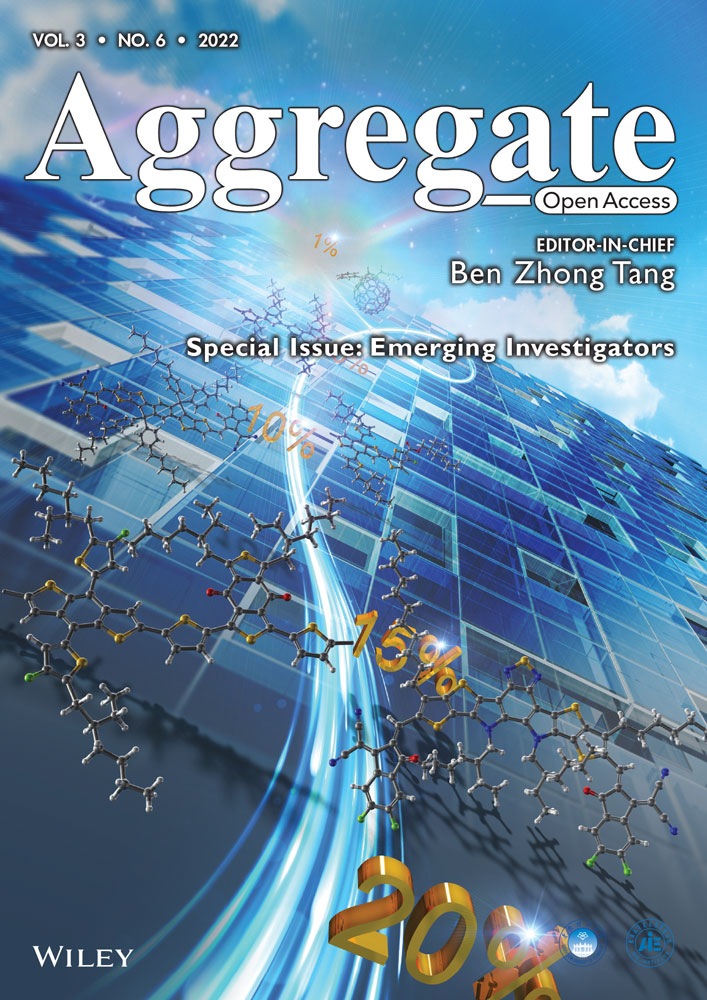Thermo-responsive topological metamorphosis in covalent-and-supramolecular polymer architectures
Special Issue: Emerging Investigators
Funding information
NSFC/China (22122105, 22071152, and 21901161); Natural Science Foundation of Shanghai (20ZR1429200); NSFC/China (22101175); China Postdoctoral Science Foundation (2021M692061); Starry Night Science Fund of Zhejiang University Shanghai Institute for Advanced Study (SN-ZJU-SIAS-006)
Abstract
Topological metamorphosis represents a powerful approach to modulate the properties of polymers. However, it still remains a major challenge to achieve the tunability of bulk mechanical properties via topological transformation in supramolecular polymer systems. Herein, we couple the covalent polymer and supramolecular polymer in a single system—referred to as covalent-and-supramolecular polymer (CSP)—to realize a thermo-responsive macromolecular metamorphosis. The CSP is able to topologically switch from grafted polymer to cross-linked network by taking advantage of synergistic dynamic covalent interactions and host–guest interactions. Benefiting from the topologically structural transformation, brittleness intrinsically evolves into toughness in our CSP architectures with minimum change of their molecular compositions from furan–maleimide to anthracene–maleimide linkers. Our work demonstrates that supramolecular polymers are a promising platform to design smart materials not only due to their inherent stimuli-responsive properties but also because of their abilities in determining bulk mechanical properties of polymers with alterable topological structures.
Morphing is a ubiquitous feature of living organisms to adapt to environmental changes.[1] For instance, sea cucumbers can alter their dermis from softness to stiffness in response to the external stimuli.[2-4] These adaptive changes of macroscopic performance are closely related to their microscopic structures. Artificial smart materials that are capable of mimicking such abilities are highly sought for applications across different circumstances. From a microscopic point of view, the properties of polymeric materials are defined by their molecular compositions and topological connections.[5-16] Along this line, it is almost impossible to program their inherent property profiles because of the inalterable topology that is typically locked at the polymerization stage. As such, much effort has been devoted to developing stimuli-triggered topology-switchable materials with coherently tunable features in recent years.[17-21] In 2017, Sumerlin and co-workers reported an ingenious design of macromolecular metamorphosis to enable distinctive topology transformations by taking advantage of the combined retro-Diels-Alder (retro-DA) unclick and DA click reactions.[22] A year later, Johnson et al. presented a smart topology-switching strategy in polymer metal–organic cage (poly-MOC) networks through reversibly changing the size and shape of photo-responsive cages.[23] In 2020, Xie group proposed a new concept of topology isomerizable network (TIN) to describe the network isomerization in couples of topological states, which allows access to readily program mechanical properties of corresponding dynamic covalent polymer materials.[24] These seminal works represent a significant step forward in the development of topological switchable materials at the (supra)molecular level. However, it is still in the very infant stage of the exciting field.
Supramolecular polymers are polymeric arrays of monomeric units, assembled together by reversible non-covalent bonds that exploit hydrogen bonding, host–guest recognition, metal-coordination, π–π stacking, and so on.[25-36] These non-covalent bonds are able to reversibly dissociate and reform under certain conditions, thereby endowing the resultant supramolecular polymers with attractive properties such as stimuli-responsiveness,[37-39] self-healing,[40-42] easy processing,[43-45] and so forth. Heretofore, topological shifts of supramolecular polymers are mainly based on the extrinsic conversion between their linear and cross-linked counterparts via reversible introduction of cross-linkers.[46-48] Furthermore, these topological transformations have failed to bring about expected mechanical performance in bulk, which has been a long-term goal in supramolecular polymer systems. Based on the above analyses, we envision that coupling the concepts of covalent polymer and supramolecular polymer in a single system would create an opportunity to realize intrinsical topological switch along with coherent improvement in bulk mechanical properties. Nevertheless, topology switchable materials based on covalent-and-supramolecular polymer (CSP) architectures have yet to be constructed.
Herein, we report a thermo-responsive topological metamorphosis in CSP architectures wherein supramolecular graft polymer (SGP) transforms into supramolecular polymer network (SPN) based on collaborative dynamic covalent bond chemistry and host–guest chemistry. In detail, SGP was composed of a covalent polymer main chain and several supramolecular polymer side chains, in which the two types of polymer chains were connected by dynamic DA adduct of furan–maleimide (Figure 1A). Therefore, the side chains of SGP were readily cleaved via the retro-DA reaction of the furan–maleimide linker at high temperatures (>120℃). Subsequently, the liberative maleimide units on the covalent polymer chain reacted with the anthracene motifs on the supramolecular polymer chain to form more stable anthracene–maleimide DA adducts between the two polymers. As a result, SGP transformed into SPN via the consecutive retro-DA/DA reactions (Figure 1B). The topological transformation of CSPs produced coherent changes in multiple properties including viscosity, sol–gel behaviors, and glass transition temperatures. What's more, the brittle and stiff features gradually evolved into elastic and tough characteristics in our topology switchable materials as manifested by their markedly changed Young's moduli (215→119 MPa), toughness (1.02→22.4 MJ/m3), and stretchability (15%→474%).
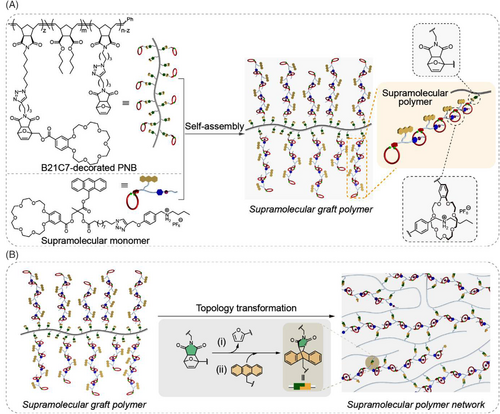
Given that the critical concentration for supramolecular polymerization of benzo-21-crown-7 (B21C7)/dialkylammonium salt-based supramolecular monomer was ∼26 mM,[43, 49, 50] the monomer concentration in our case was set as ∼50 mM to enable supramolecular polymerization with high-efficiency. When the B21C7-decorated polynorbornene (PNB) and supramolecular monomer were dissolved in dichloromethane (DCM), the SGP was formed via host–guest recognition between B21C7 and its complementary dialkylammonium salt (Figure 1A). As we know, the thermally labile furan–maleimide adduct is separable at high temperatures (>120℃), while thermodynamically preferred [4 + 2] cycloaddition product between maleimide and anthracene moieties could be formed near-quantitative at these elevated temperatures.[51] Therefore, in our case, we took advantage of such consecutive reactions to study the polymer topology transformation. Notably, to alleviate the negative effect of by-product 17 which could act as the polymerization inhibitor to impede the formation of SPN in the process of topology transformation, we introduced the comonomer 19 without B21C7 unit for the preparation of the PNB (Figure S2).
The CSP structures were firstly characterized by 1H NMR experiments (Figure S31). Before the transformation, the proton signals corresponding to the furan–maleimide adduct were obvious at δ = 6.5–6.7 ppm. When the topology switch happened, the signals of furan–maleimide adduct disappeared and newly emerged anthracene–maleimide bridgehead protons at δ = 4.9 ppm were observed. These results indicate that the dynamic reactions in our case are feasible.
Anthracene is an efficient chromophore, which thus inspires us to track the topological transformation via fluorescence spectra. The fluorescence intensity of CSP was chronologically decreased and reached an equilibrium after being transformed for 58 h (Figure 2A). However, a sudden change in the fluorescence intensity of CSP was observed in the range of 48 to 58 h, we speculated that it might result from the experimental error due to the uncontrollable volatilization of DCM and inaccurate measuring of the reaction mixture. Even so, the descending trend in fluorescence intensity indicated that the anthracene moieties were gradually consumed by the liberative maleimide groups via thermally favored [4 + 2] cycloaddition, and hence diminished the fluorescence. Notably, the signal cannot be quenched completely because an excessive supramolecular monomer was employed to lengthen the side chains of SGP. To further confirm the observed architecture changes, we also performed the UV–vis spectroscopy measurements. As expected, the absorbance of CSP showed inversely proportional to the thermo-treatment time and reached the equilibrium after 48 h (Figure S34). This observation further supported the conversion from furan–maleimide linker to anthracene–maleimide one.
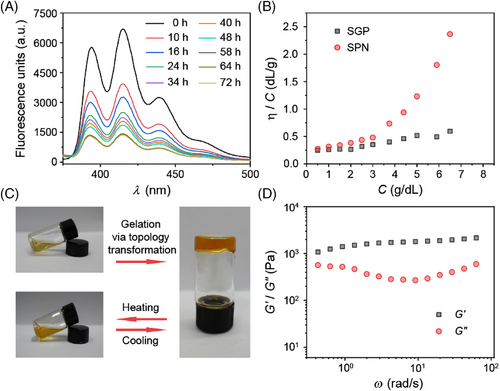
According to our design, the grafted CSP could topologically transform into a cross-linked one via thermo-induced formation of anthracene–maleimide linker from furan–maleimide adduct. Therefore, we performed viscometry measurements to explore their reduced viscosities as a function of polymer concentrations using a Cannon-Ubbelohde semimicro dilution viscometer in CH2Cl2. The reduced viscosity of SPN increased exponentially from 0.27 to 2.37 dL/g in the concentration range of 0.5 to 6.5 g/dL (Figure 2B). This is in sharp contrast with SGP, whose viscosity only underwent a minor linear increase in the same concentration range. The viscous changes in solution encouraged us to further investigate their gelation behaviors. At 45 mg/mL, SGP was well soluble in CH2Cl2. However, the same concentrated SPN could form a gel in CH2Cl2 at room temperature (Figure 2C). Frequency sweep test of the SPN gel showed that the storage modulus (G′) was always larger than the loss modulus (G″) over the measured frequency range, reflecting a solid-like property (Figure 2D). Moreover, in view of the dynamic nature of host–guest recognition, the resultant SPN exhibited a thermo-triggered gel–sol transition and vice versa (Figure 2C).
Heretofore, we have demonstrated the thermo-responsive macromolecular metamorphosis from SGP to SPN in solution. Next, we proceeded to exploit their bulk properties before and after transformation. In thermogravimetric analyses (TGA), both SGP and SPN showed good thermal stability with decomposition temperature (5% weight loss) higher than 200℃ (Figure S38). As observed by differential scanning calorimetry (DSC), the Tg values of samples showed a descending trend, which decreased from 51.5 to 24.6℃ as the thermo-treatment time increased from 0 to 48 h (Figure 3A). In our case, the change in Tg could be ascribed to the topology transformation of CSPs. For SGP, the rigid supramolecular polymers were dangled from the PNB main chain, which rigidified the soft polymeric backbone, thus leading to a high Tg of 51.5℃. For SPN, the rigid supramolecular polymers and soft PNBs were interwoven together, which suppressed the aggregation of supramolecular polymer, giving rise to an elastomeric material with a low Tg of 24.6℃. Furthermore, dynamic mechanical analysis (DMA) also proved that SGP possessed higher storage modulus (E′) and transition temperature than those of SPN (1.36 vs. 0.70 GPa; 75.7 vs. 63.7℃) (Figure 3B). These sharp changes suggested the topology switch between SGP and SPN.
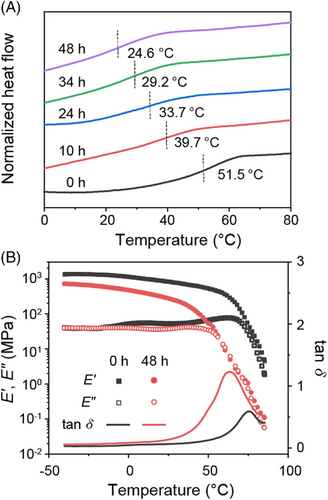
To further investigate the change in mechanical properties of the samples resulted from the topology switching, we carried out tensile tests. SGP was a stiff and brittle material whose fracture stress and maximum strain were 8.6 MPa and 14.9%, respectively. When the thermo-treatment time was extended, there were obvious changes in mechanical behaviors. For example, maximum strain of the sample increased from 80.9% to 239% and then 474% as the heating time increased from 10 to 34 h, and then 48 h (Figure 4A). Of interest, the fracture stress of the samples kept relatively stable values of 8.6 and 6.4 MPa before and after transformation (Figure 4B), although their Young's moduli reduced a lot (215→119 MPa) (Figure 4C). In addition, SPN had a significantly increased toughness (1.02→22.4 MJ/m3), which was nearly 22 times higher than that of SGP. These results indicated that the same supramolecular polymers could play different roles in determining mechanical properties of CSPs with different topological architectures. For SGP, the side chains of rigid supramolecular polymers were dangled from the PNB main chain, which governed its flexibility, and thus resulted in a high stiffness. For SPN, supramolecular polymers interwove with covalent polymers to form network structure via the anthracene–maleimide linker, wherein the host–guest interactions acted as sacrificial bonds to toughen the material via an energy dissipation pathway. As a result, the metamorphosis from SGP to SPN represented a transformation of stiff but brittle material to a strong yet tough one.
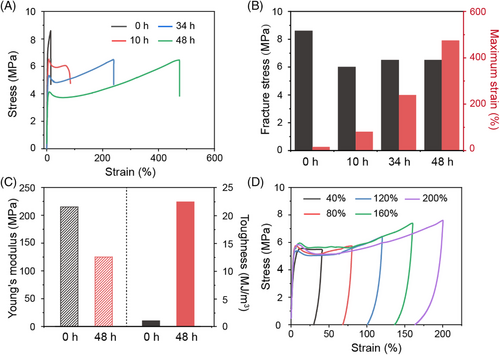
After confirming the alterations in mechanical properties influenced by topological transformation, we ulteriorly examined the dynamic characteristics of the newly formed SPN. Its mechanical properties were found to be dependent on stretching ratios, suggestive of the role of supramolecular interactions in dynamic material (Figure S40).[39, 52] Cyclic tensile tests were further conducted over a broad range of applied strains from 40% to 200% (Figure 4D). After each loading-unloading cycle, substantially enhanced hysteresis loop and residual strain were observed, which implied the ability of energy dissipation by rupture of reversible sacrificial bonds in SPN.
In summary, we have proposed a paradigm of macromolecular metamorphosis in a supramolecular polymer system by unification of host–guest interactions and dynamic covalent bonds, which render enhanced mechanical performance under thermal stimulus. Relying on the consecutive retro-DA/DA reactions, the topology of CSP architecture switched from grafted polymer to cross-linked network. The transformation elicited a shift from stiff but brittle material to a strong yet tough one, which in turn provided an opportunity to tailor the mechanical properties of transformable polymers. On the basis of our findings, we believe that supramolecular polymer-based topology switchable materials would have promising applications in mechanically adaptive elastomers, artificial muscles, and soft actuators.
ACKNOWLEDGMENTS
Xuzhou Yan acknowledges the financial support of the NSFC/China (22122105, 22071152, and 21901161) and the Natural Science Foundation of Shanghai (20ZR1429200). Zhaoming Zhang acknowledges the financial support of the NSFC/China (22101175). Xinhai Zhang acknowledges the financial support of China Postdoctoral Science Foundation (2021M692061). This research is supported by the Starry Night Science Fund of Zhejiang University Shanghai Institute for Advanced Study (Grant No. SN-ZJU-SIAS-006).
ETHICS STATEMENT
This article does not involve any human investigation or animal experiment.
CONFLICT OF INTEREST
There are no conflicts of interest to declare.
Open Research
DATA AVAILABILITY STATEMENT
The data that support the findings of this study are available from the corresponding author upon reasonable request.



